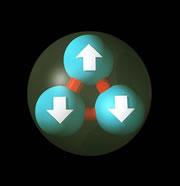 Trios of quarks make up protons and neutrons (shown), but five quarks together would be extremely unusual.© SPL
Trios of quarks make up protons and neutrons (shown), but five quarks together would be extremely unusual.© SPLPhysicists have come home empty-handed from a thorough hunting expedition for pentaquarks. The lack of evidence has led some to doubt that these odd subatomic particles, first sighted in 2002, actually exist.
The pentaquark was discovered at the SPring-8 synchrotron in Harima, Japan1. The particle, thought to be made up of five quarks, is so unstable that physicists inferred its existence from the debris of collisions between gamma rays and carbon atoms.
Trios of quarks make up the protons and neutrons that are the basic building blocks of atomic nuclei. Particles made up of five quarks would be extremely unusual, and were hailed as a new form of matter.
“These data for the existence of pentaquarks do not look convincing.”
Curtis Meyer
Carnegie Mellon University
But experiments at the Thomas Jefferson National Accelerator Facility in Newport News, Virginia, now suggest that the discovery was a mistake. "We just didn't see it in these experiments," says Raffaella De Vita, of the National Institute of Nuclear Physics in Genoa, Italy, who presented the results at the American Physical Society conference in Tampa, Florida, on 16 April.
"I think this is the only lab in the world to repeat the experiments with at least ten times the sensitivity," says Marco Battaglieri, one of De Vita's colleagues. "It's the first time we can look at this problem with really good statistics," he says.
Searching highs and lows
The results fuel a controversy that has raged since the first pentaquark sighting was confirmed by more than ten other labs, which looked back through the results of similar collisions to search for evidence of the particle. "In 2003, there were lots of positive results, everybody found something," says Battaglieri.
But in 2004, results from higher energy collisions showed no trace of the pentaquark, throwing the original discovery into doubt. Higher energy collisions generally give more statistically significant results, but some scientists argued that these conditions were obliterating any evidence of the pentaquark.
So the Jefferson team mounted a rigorous safari of the debris from a gamma-ray collision on a liquid hydrogen target, repeating an experiment from the Electron Stretcher and Accelerator in Bonn, Germany, that claimed to have found the pentaquark.
"The data for the existence of pentaquarks do not look convincing," says Curtis Meyer, a particle physicist from Carnegie Mellon University in Pittsburgh, Philadelphia, who presented a detailed comparison of the pentaquark experiments at the meeting.
Meyer says that after the SPring-8 discovery was announced many groups prematurely jumped on the pentaquark bandwagon. "Some of those results were really on the edge," he says. Battaglieri adds that the original sightings were probably just background noise from the experiments.
Quark soup
ADVERTISEMENT
Scientists study how quarks stick together because they make up most of the matter we see around us. Theorists believe that in its first seconds, the newborn Universe was filled with a plasma of quarks and gluons, the particles that bind quarks to each other. Understanding this quark soup could reveal why the Universe evolved into the form we see today, says Meyer.
Efforts to find the pentaquark have not been a wild goose chase, Meyer concedes. "It really caught the attention of the community for a few years, and delivered a lot of good theoretical work," he says. Meyer adds that experiments at the Jefferson lab later this year will probably convince any remaining doubters that the particles do not in fact exist.
Carnegie Mellon University
